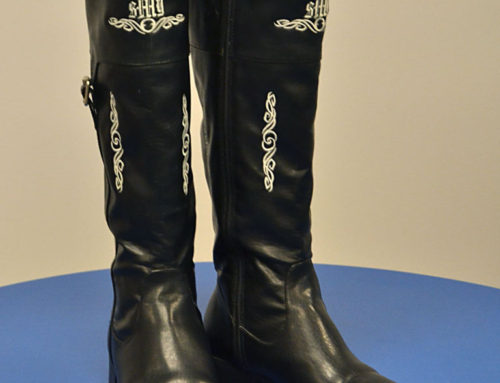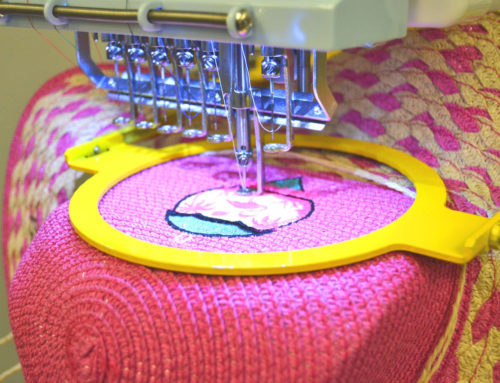If you ever see the outlines of your designs “run away”, design parts not lining up, stitches missing, fabric puckering or thread looping – these simple tips may help.
Basic Tips for Great Stitchouts
Hooping has enormous effect on embroideries quality. Because of improper hooping, it often looks like the design we’re embroidering is inferior. Fortunately, 95 times out of 100 it’s not the case!
Yet, to achieve great results, it’s not enough to hoop well. There are a few steps that must be done right, in addition to proper hooping. We’ll try to mention them too, to help you avoid painful pitfalls :o) Here they are:
1. Launder the fabric you’re going to embroider on, to pre-shrink it. Use the same washing conditions you’re going to use on your ready item later.
For example – if it will be “machine boiled” at 95 C – machine boil the fabric before embroidering. Because if you forget to do this, it can shrink later, together with the design. Then the fabric will pucker and look terrible.
2. Stabilize properly to prevent fabric puckering, fabric stretching & deformation of ready embroideries after laundry. Use water soluble topping to stop stitches from sinking into stitches-observing fabric types.
3. Always use EMBROIDERY supplies. This may sound trivial, but sewing threads, for example, are not good for embroidery, because of their low quality.
So don’t try to save by shopping for sewing thread for embroidery purposes. Instead of saving money, you will only harm your embroidery machine & get terrible stitchouts.
Always order quality embroidery supplies, so that you and your machine would be happy and healthy!
4. Take a piece of identical type & weight fabric and do a test stitch of your design with exactly the same materials you’re going to use on final project.
This will help you see whether your decision about stabilizing and other materials selection was good.
Test until you pick up materials that work great together.
We even suggest that you use the same thread colors, to make sure these cones include quality thread. Because sometimes one color embroiders beautifully, while other is a disaster. This happens with most expensive thread brands, nobody is insured.
If you don’t do such testing, you’re gambling. Don’t gamble, because it’ll cause you disappointment. It’s sad to see a ruined project.
5. Take a new 12/80 needle every 8 hours of embroidering. It must be sharp and not “hooked”.
Otherwise your thread may start looping. Just because of bad needle, your machine can even start missing stitches.
Hooping Tips for Great Stitchouts
It’s hard to undervalue the importance of quality hooping, because most times we have troubles with designs not lining up and fabric puckering, it’s because of incorrect hooping.
You’ve probably heard about “in hoop” and “hoopless” embroidery, and even know the difference between these two terms. Nevertheless, we will explain them both, to avoid confusion.
“In Hoop” Embroidery – What it Is & When to Us
This term relates to all cases when you hoop the fabric you’re going to embroider on.
“In Hoop” embroidery is usually used whenever you have no problems with hooping the material you want to embroider on. To summarize – if your item is large enough to be hooped, the fabric is not too fat and not too slippery, and the hoop won’t damage the fabric – it’s usually easier and better to hoop. Together with embroidery backing, of course…
“Hoopless” Embroidery – What it Is & When to Use
This term relates to all cases when you hoop only embroidery backing, and the main material you want to embroider on is not hooped, but gets sticked over the hooped backing.
Sometimes this can be achieved using adhesive stabilizer, sometimes – by applying temporary spray adhesive to regular backing. But the result is always the same. The backing is carefully hooped, and fabric secured over it.
This method is wonderful for several situations:
1. When your fabric is very slippery. It works better than regular hooping with slippery fabrics, because this way the backing “sits” well between the hoop rings and provides stability, while the fabric doesn’t have any chance to slip, because it’s glued to the backing!
2. With small items. If you want to embroider on something tiny that isn’t possible to hoop, like collar for example, you may just hoop embroidery backing, “glue” the non-hoopable item to it and embroider.
3. With fabrics that are too fat to hoop the regular way – like polar fleece, fat bath towels, fur etc.
4.. With materials that can be damaged or stretched if hooped – like corduroy, velvet, knits, paper, leather.
Basic Hooping Technique
Remember. No matter if you’ve decided to use “in hoop” or “hoopless” method, you need to hoop, and hoop well. The only difference is that in first case you hoop the backing and fabric together, and in second case – only the backing.
When hooping, whatever material you hoop – it should be quite tight (not loose, without “bubbles”).
Yet, NEVER, NEVER stretch your fabric or deform it. Because when you will finish embroidering and unhoop – it will return to it’s original shape, creating ugly puckering.
To achieve such result, you may hoop the following way:
1. Lay the bottom hoop ring, with loosened screw, on working surface.
2. Put stabilizer & fabric over it. Using your fingers, feel where the bottom ring is positioned.
3. If you’re using large hoop, or a bit slippery fabric, or your hoop is just known for not holding fabric well enough – do the following:
- Take 4 paper towels, fold them 2 times, and put each long folded piece over one hoop edge.
- They will make your fabric hold better in hoop, without moving.
4. Using both of your hands, slide the upper hoop ring inside. You should see NO fabric or stabilizer bubbles.
If you see them – retry until the surface is wrinkless.
Tighten the screw. If you’ve used paper towels – cut the excess of paper towels, that you see entering the embroidery area.
5. Take the hoop to your hands, and insert the upper ring a tiny bit more inside (~ 1/8 inch inside).
6. In case you hoop the backing only – now spray temporary spray adhesive on your hooped stabilizer, and carefully stick the fabric.
Ready! Wish you a wonderful day & happy embroidering!

